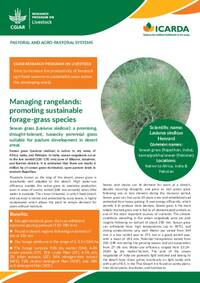Managing rangelands: promoting sustainable forage-grass species: Lasiurus sindicus Henrard: a promising, drought-tolerant, tussocky perennial grass suitable for pasture development in desert areas
Published Date
January 25, 2019
Type
Brief

Authors:
Arun K. Misra, Mounir Louhaichi
This is a factsheet about Sewan grass (Lasiurus sindicus) that Popularly known as the king of the desert, sewan grass is remarkably well adapted to the desert. High water-use efficiency enables this native grass to maximize production even in areas of scanty rainfall (100 mm annually) when little water is available. The crown (rhizome), in which food (starch and sucrose) is stored and protected by scaly layers, is highly compressed, which allows the plant to remain dormant for years without moisture. This factsheet describes the plant benefits and management.
Citation:
R. N. Kumawat, Arun K. Misra, Mounir Louhaichi. (25/1/2019). Managing rangelands: promoting sustainable forage-grass species: Lasiurus sindicus Henrard: a promising, drought-tolerant, tussocky perennial grass suitable for pasture development in desert areas. Beirut, Lebanon: International Center for Agricultural Research in the Dry Areas (ICARDA).
Keywords:
lasiurus sindicus
desert
grasses
pastures
